9/21 - Friday – Charlottetown (PEI) to Cheticamp, Cape Breton Island (Nova Scotia)
Bob made us breakfast early (7:30 am) so we could catch the ferry at 9:30 – another lovely fruit salad, egg and cheese scramble and blueberry muffins. Aldine stopped in the kitchen on her way to work to check on things. She admonished Bob for serving the muffins in at bowl. Not a problem for us. Poor guy, it just wanted to feed us and get out to the golf course.
“The Bitch” got us to the ferry landing at Wood Islands in plenty of time. It was amazing to see the streams of cars and buses and trucks filling up the bowels of the ferry. We parked 5 levels down and then went up on deck. We grabbed a table to finish our postcards and figure out lodging options for tonight. Someone spotted a whale so we all ran out on deck to catch a few glimpses of a black tail in the vast ocean. The ferry was loaded with tour groups, looking bored. Some were reliving their last great trip – a tour to Branson. Get me out of here!
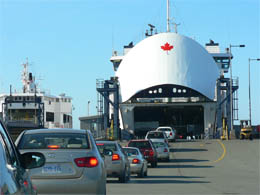
Loading up the ferry |
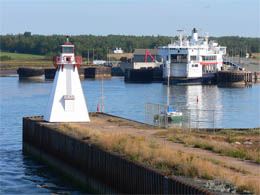
Lighthouse to guide the ferry |
We de-boated in Caribou, Nova Scotia and headed east to Cape Breton Island. We got gas ($1.07 per liter) and then stopped at the Port Hastings Visitor’s Center. We talked with friendly Rosie who made some calls and then booked a place for us. She told us about her mischievous cat who ruins all her re-upholstery projects. After our chat with Rosie, we got back into our car and turned “The Bitch” on. We drove down Highway 19 along beautiful coastline, farmlands and rivers, but no towns for miles and I was famished. (“The Bitch” also managed to get us lost again!) Finally I spotted a sign posted by a lonely building that said, “2 Cheeseburgers for $6.” In spite of the isolation, I insisted we go back and check out the place. We were the only customers. It took forever to get our cheeseburgers -- no fast food here! Boy, were those burgers good – topped with sautéed onions and a plate piled high with fries.
I got my strength back in time for the next stop – a tour of Glenora Distillery, 45 minutes from the Canso Causeway. Built in 1990, Glenora is North America’s only single malt whisky distillery. It’s renown for the Scottish whiskey. We paid $7.50 each for the 3 o’clock tour.
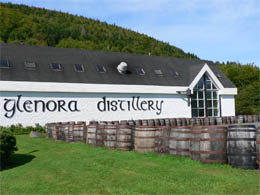
Glenora Distillery |
We waited in the bar and listened to Pius MacIsaac play Scottish folk tunes, switching between fiddle and mandolin and occasionally singing along. The whole place was vibrating as his clubfoot in his big-heeled shoe tapped out the rhythm on the wood floor. We were the only ones to clap and chat with him between numbers. His music was the real deal, straight from the soul. We bought a CD from him for $20. He talked with a thick Scottish accent. When we shook hands, I noticed that he couldn’t straighten the third and fourth fingers on his right hand. How could that arthritic hand make such amazing music?
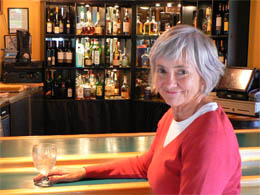
Nancy at the bar |
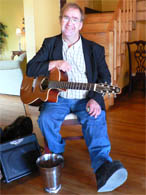
Pious, The Scottish Fiddler |
The tour started promptly at 3. Our guide, an angry hostile young woman with a stud in her nose, would rather have been anywhere but there. She put on her automatic tape: “The distillery was built in 1990 and produced its first product in 2000. The owner selected the distillery’s location because of the pure water that runs in the streams . . . blah, blah, blah.” I remember a few other key words – rye, malt, distill, barrels, sugar, etc., but the concepts were quickly washed away by her boredom. She led us into a couple of other rooms with bright and shining equipment. She said nobody was around because they only made whisky from October to January. She poured us each a shot from a bottle that took 10 years to mature and costs $79.29. She ended abruptly with a hostile glare and the obligatory comment - “Any questions?” All ten of us in the tour knew our time was up. As we were leaving, I thought if a bottle of whiskey takes tens years to mature and a lobster takes seven, then one human can wipe out a lot of years during one single dinner. Aren’t we something!
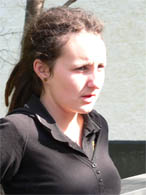
The angry young tour guide |
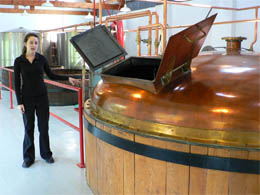
“Do I care?” |
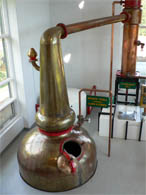
Touring the distillery |
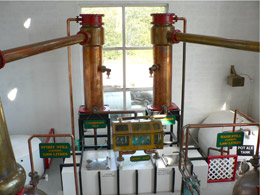
Touring the distiller |
We were glad to get back on the road, headed for our final destination. Then Bill and I started a debate – “Was the Scottish musician’s name Bius or Pius?” I looked for our CD to end the debate, but discovered it wasn’t in the car. We had left it on the bar – so we turned around and went five miles back to the distillery to retrieve our CD. We passed our guide from hell leading another tour group – God bless them all!
We gave “The Bitch” directions and put Pius’ music on. (By the way, Bill was right – It was Pius). “The Bitch” kept yelling directions over Pius’ jumpy fiddle tunes – not a nice combination for the nerves. We were tired and turned both the music and “The Bitch” off for a little quiet time.
An hour later we arrived at our B&B – L’Auberge Doucet Inn, set off the highway on a winding road, peacefully nestled on a hill with ocean views ahead and mountains behind. HOWEVER, don’t let this fool you -- it was the worse place we stayed on our whole trip and put us out $90 a night. It looked like it had been remodeled in the early 80’s. The blonde furniture was broken, instead of artwork there was a tattered tourist map thumb-tacked to the wall, the mauve shades on the wallpaper were faded and the scent of smelly feet was strong. However, the room was big and quiet – quiet simply because no one else was here. We were sorry we had booked ahead because now we were stuck.
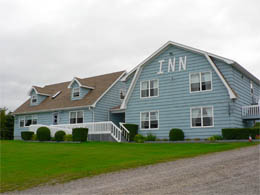
L’Auberge Doucet Inn – Do not stay here! |
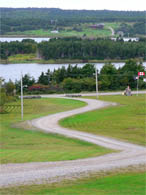
Driveway to the Inn |
We tried to relax, but the environment was depressing. Bill and I couldn’t get the old Scottish tunes out of my head, so we drove on into Cheticamp for our big night on the town. The main road (going north) was a single strip of simple rustic houses on the right reflecting the magnificent sunset on the left. Any of these scenes belonged on a picture postcard. We drove through town and on down to the Cape Breton National Park Headquarters and then returned to town for dinner.
We stopped at the Acadia Co-op (with lots of needlework) and went downstairs to the free museum. Here we met Edna, sitting there alone “hooking.” She was spunky and fun and entertained with a steady flow of dialogue mixed with laughter. She was married 41 years ago on Sept. 5th. We were married 41 years ago on Sept. 2nd. She had a sense of adventure and wanted to see the world. That is where the similarities ended. Her husband is the town’s barber. When she was 23, she went to Ontario with him for a year while he attended Barber school. She was thrilled to get a taste of the outside world, but when he graduated, he returned to Cape Breton to be close to his family. They have two sons – one is a fisherman. She does odd jobs to help out – and hooks rugs. She refers to herself as a “hooker.” I could have listened to her stories all evening, but some other travelers showed up and diverted her attention. I thought how happy she seemed, but how much she want to see. Why am I so lucky?
We ate at the place next door – The Acadian Restaurant – They had senior portions (and prices) and we were tired of stuffing ourselves. It turned out to be great – wonderful fresh, home cooking with a delightful, fun loving Acadian server – I like their style. We had pan seared haddock, fish cakes, veggies, mashed potatoes (really fresh, right out of the ground), tea, homemade cinnamon roll with peach yogurt ice cream – YUM YUM and all for only $6.95 a plate.
We went back to our quiet room with the musty “Ode to Smelly Feet” scent to plan some hikes for tomorrow and try to forget where we were staying.
9/22 - Saturday – Cheticamp, Cape Breton Island (Nova Scotia)
The breakfast at the Inn was only so-so. Bob spoiled us. The waitress told us about a terrible accident that happened about dusk the day before. A couple of tourists in their rental car came around a corner and slammed into a moose. One of them had to be life-flighted to Halifax. The waitress said it happens all the time around here. Apparently when you hit a deer, it just damages your car, but a moose is taller and weighs a lot more than a deer. You hit a moose at the knees and that hurls the body directly into the windshield. I’m not as anxious to have a moose encounter of any kind after that dreadful story.
We stopped in town at the Acadian Restaurant (where we dined the night before) and got two turkey sandwiches to go (no more sharing turkey sandwiches for me). Then we took the beautiful Cabot Road to the Visitor’s Center at Cape Breton Island National Park. The Ranger Gal pointed out some of her favorite hikes and then stored our turkey sandwiches for us. (That would never happen in the U.S. – “We have rules …. If we did that for you, we’d have to do it for everyone … etc.” I like being in a place where people don’t worry about rules or lawsuits – they only want to help you out.)
First Hike – Acadian Trail – 6-mile loop trail with 1200’ elevation
We climbed steadily upward through a thickly wooded forest, passing lots of birch trees. We crossed a babbling brook several times with scenes that looked like the early American print that hung over the couch in the house where I grew up. (My mother still has that picture.) The hike, like the picture, was boring until we got to a clearing with a lookout with spectacular views of the coastline below. (I had to stop and pee just when another couple appeared out of nowhere – close call.) We saw a hawk (or maybe it was an eagle), a squirrel and a little scared brown toad. You don’t see many toads or frogs anymore, especially ones that aren’t deformed.
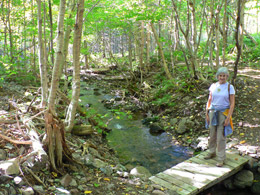
Nancy crosses a stream |
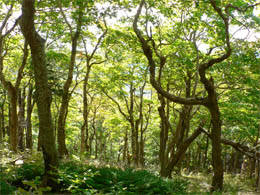
Boring, endless woods |
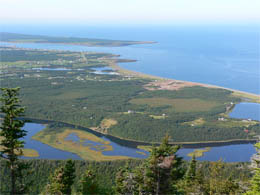
View from the overlook |
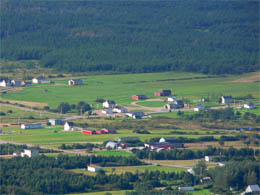
Closer View of Cheticamp |
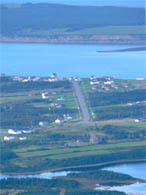
Cheticamp’s main road |
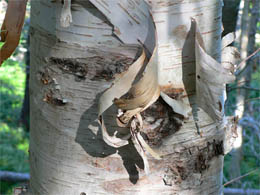
Peeling bark on a Birch tree |
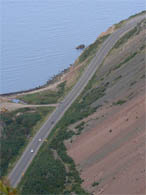
View of Cabot Trail from the overlook |

Little squirrel on the trail |
We hiked back to the Visitor’s Center to watch a useless orientation video. We bought Zi a book on wildflowers and then collected our turkey sandwiches. We had our picnic down by the beach where someone had built a strange rock-man.
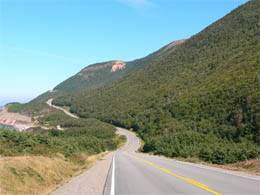
Beautiful Cabot trail through the park |
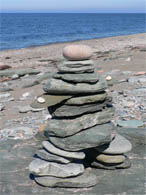
Rock man by the ocean |
Second Hike – Bog Trail – .5 mile over a boardwalk
We’re fascinated by the things we saw in the bog – pitcher plants, sphagnum moss, and wild orchids that bloom in the spring. It takes 14 years to produce an orchid. Swamp life is tough!

The Bog |
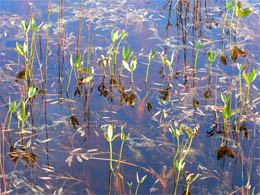
Close up of the Bog |
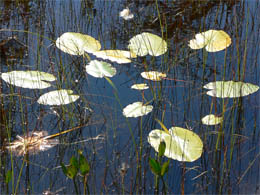
Lily pads |
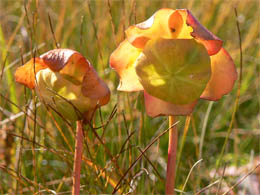
Pitcher Plants |
We were annoyed by the hundreds of motorcycles that rode through the park on that Saturday. None of them seemed to know about mufflers. Later we learned that they were riding to raise funds for the CURE (for breast cancer) – we so felt better about sharing the road with them.
Third Hike – Skyline Trail – 5 mile loop (with promise of moose, but only saw a pile of fresh moose dung)
Same scenario as most trails in these parts. They start out in heavily wooded areas with no views and just when you’re starting to get bored, you come to a clearing topped off with an overview that takes your breath away. We had an eye-popping view of the ocean with the Cabot trail snaking its way through steep cliffs.
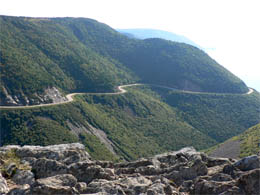
Overlook - Cabot Trail |
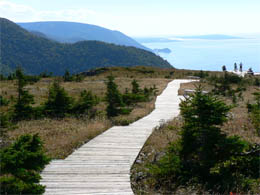
Trail to the edge of the cliff |
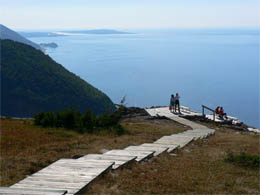
What a view! |
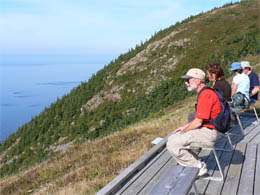
Bill viewing the pilot whales in the water below |
At the edge of the cliff, we looked down into the ocean for a site that we’ll never forget. There was a huge pod of Pilot whales--probably a hundred--along the coastline feeding on mackerel. At first we thought the forms in the water were rocky outcroppings – but then we noticed them move – these silent ghostly enormous figures. Several awestruck people gathered to share the excitement. We didn’t want to leave, but after an hour, a beer was calling, so we hiked back to the car to head to town. What a day – We did about 12 miles of hiking in picture perfect weather. Expecting rain tomorrow.
We drove into Cheticamp, stopped and snapped a picture of St. Peter’s Church – seems much too big a scale for this little town. Then we went to the Visitor’s Center to check emails. The Visitor’s Center also had a mini museum where I added some more pieces to the history of this island first called Acadia.
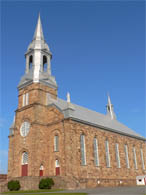
St. Peter’s Church |
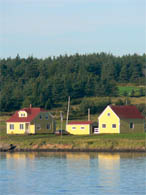
Cheticamp |
Now for a little history about this place . . .
In 1605 the first French settlers came. They farmed, fished and trapped and got along great with the local Mi'kmaqs. (Native people are called Aborigomies around here.)
The Brits came next with their main goal to conquer. They took over officially in 1710 and then continued to worry as the French population increased. (Plus the Mi'kmaqs and the French supported each other in the effort to oust the Brits.) In 1755, the Brits showed their muscle and had all the French deported – some back to France, some to jails in England, but most to New England. Over the years, the Brits mellowed and allowed some of the French to return from England. They were also
desperate
for white folks to settle their colony. They granted 14 French
families
the right to settle by the ocean (near where we ate lunch today). The community grew and became established. Then in 1936, the area became a National Park.
The Scottish settlers came to Cape Breton Island. They choose this place because it was like the Scottish Highlands from home. Even today there are still strong Scottish accents and strong Scottish traditions. Scholars come to Cape Breton to study the language, music and customs of the
Gaelic
Culture because the Scottish traditions are still “pure.” As the 1800’s progressed, the Scottish highlands changed with each new wave of European influences, but here, on the Cape, the culture is preserved.
The Irish also played a role in settling this remote Cape – and their music and culture remain pure. We feel like we’re in a strange little Munchkin land where music and traditions and hookers rule.
|
In our quest for a beer, we stopped back in at our favorite haunt, The Acadian Restaurant. They weren’t serving just beer – so Bill suggested that we go back down the road to Doryman’s. The outside was an old falling down bar, but inside, on that late Saturday afternoon, the local color was vibrant. There must have been about 50 to 75 locals. With missing teeth, lack of nametags, jewelry, and fancy traveling attire, you could clearly tell there was no escapee from a tour group. And were they grooving on the fiddle and keyboard music. The guy, racing his bow across the strings of his fiddle, was absolutely amazing. How could his arm not be tired? The older guy on the keyboard was good, but I was fixated on his very bad toupee and strange doll-like false teeth. He looked like he belonged in a Wax Museum. After a couple of sets, these guys had worked the crowd up into frenzy. Our neighbor, at the next table, grabbed the waitress and they flew into some strange jig with legs flying. An older gentleman was making chicken-like moves on the dance floor. This stuff was in the genes. One felt the whole soul of the place was opening up. After a couple of encores, the fiddler had to stop or would probably never get the feeling back into his arm. We were sorry to see the show end. We poured out into the parking lot with the rest of the crowd headed for dinner.
We decided to try someplace different tonight and drove right by our favorite Acadian Restaurant to The Seafood Stop, a place highly recommended by Brenda (the business woman we met in Charlottetown). We ordered the seafood chowder and a salad. Do not eat here – THE WORST MEAL anywhere, ever! The bad news is that the chowder tasted rancid. The good news – the servings were small. We choked it down and then worried about getting sick. The limp iceberg lettuce leaves didn’t add anything to the meal. We were glad to pay the bill and get the hell out of there.
After our most disappointing dining experience, we didn’t want to go back to our pitiful, depressing room at the Inn, so we drove to Cheticamp Back Road where the French established a town to hide from the British for a hundred years or so. When the Brits mellowed out in the late 1700’s, the French moved to the current location, taking the original church apart stone by stone and then reassembling it in the center of their new town. We couldn’t find any more adventures, so we went back to our room for the night.
9/23 - Sunday – Cheticamp, Cape Breton Island (Nova Scotia) to Baddeck
Had breakfast at the Inn – couldn’t believe that most of the rooms at the Inn were filled. We packed up and headed north -- glad to be moving on.
It was a gorgeous drive on the Cabot Trail through the Cape Breton Highlands National Park. At first we noticed some light mist on the windshield, then some droplets and then came the thick fog obscuring the dramatic views of the rugged coastline and highlands – and possibly a few moose hidden out there somewhere.
The drizzle let up a bit so we stopped to do a mini half-mile hike winding through a gorgeous forest with beautiful 200-year old sugar maples and crossing a stream to Lone Shieling, a replica of a Scottish Sheep Crofter's Hut. (A Crofter is a tenant farmer.) The shieling is a small hut, made of stonewalls and a thatched straw roof. During the summer, crofters grazed their livestock on these hill pastures of clan chieftains. The shieling (hut) sheltered the crofter and sometimes, his livestock. The trail gave me an insight into the life of the early Scottish settlers of Cape Breton. I loved the green – green forests and rushing streams. There was a sweet family on the trail with the Dad explaining things to the kids. The mosquitoes decided to attack Bill, so we headed back to the car.
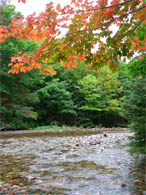
Rushing stream |
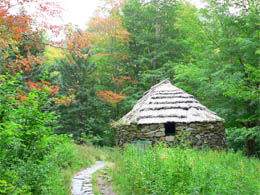
Lone Shieling Trail |
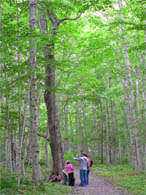
Sweet Family in the Forest |
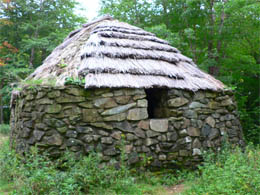
Lone Shieling |
We took the local road to White Point and were treated to amazing sights – quaint fishing village after fishing village with paint peeling on the buildings and houses. Big fishing boats were parked out on the front lawns -- one boat was named “Nancy B.”
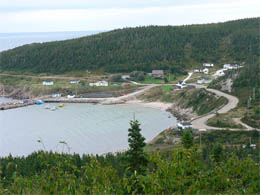
Road to White Point |
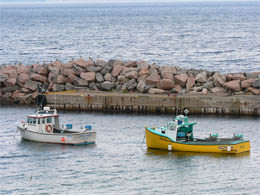
Scenes along the road |
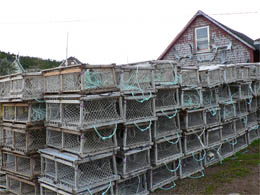
Lobster traps stacked in front of a house |
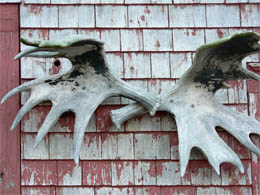
Moose horns hung on the side of a house |

Red berried trees and bushes along the road |
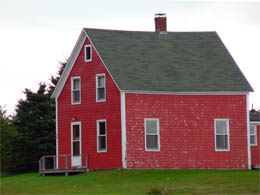
Red house – can’t possibly be quainter |
Neil’s Harbor, another tranquil fishing village along the road, had its own Lighthouse on the town dock. On the dock was the funky Chowder House – but it was too early for lunch and neither of us could bare to say the word “Chowder” after last night’s chowder from hell encounter.
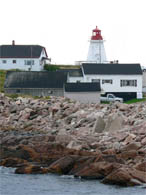
Neil’s Harbor |
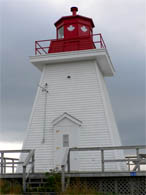
Town Lighthouse |
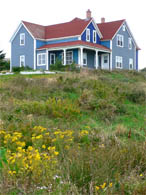
Neil’s Harbor |
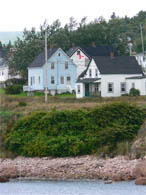
Neil’s Harbor |
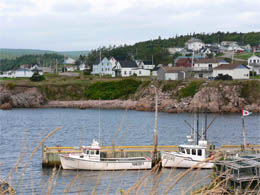
Neil’s Harbor |
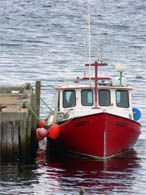
Boat called “Indept” |

Dock at Neil’s Harbor |
We drove a ways on the road along the coast to Ingonish and stopped at a place called Coastal Waters Restaurant – great little place. We had the special – chicken salad sandwiches and basil tomato soup. Most of the folks around us were woofing down huge quantities of fish and chips, feeding their big behinds. (I’m starting to miss those Californian salads.) While we were paying our bill, I saw Sunday’s paper headline– “Canada’s Looney is equal to U.S. Dollar – a First.” That sent us into a tirade about how this trip is costing us 30% more because of Bush’s stupid economic policies – That loser leader.
The sun seemed to be winning the battle against the clouds – so we stopped to be in the glorious outdoors. The Ingonish area has a couple of beautiful bays. We took the hike to Middle Head, starting behind the historic, Tudor-style Keltic Lodge.
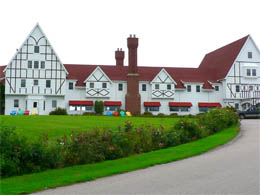
Keltic Lodge |
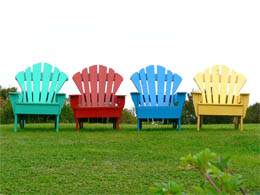
For Guests of The Keltic Lodge |
The ridgeline, 2 ½ mile Middle Head trail has great views of the cliffs and rocky beaches below. I also passed meadows filled with wild flowers. We saw an eagle fly a few feet over our heads. At first we thought it was a crow, but then we noticed it’s white head and broad shoulders – so exciting.
Posted on the trail was this sobering poem:
The end of land
We belong to ocean and sky
Clean air, clean water, food
Gifts to all
Life
We ruin with pollution and greed
The end
No life
Cloud, ocean and sun
Empty
Waiting for time
Like the beginning
|
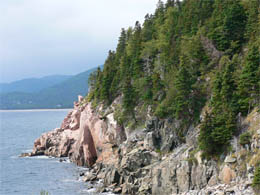
Rugged cliffs |
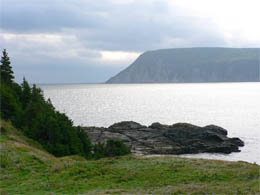
Middle Head Bay |
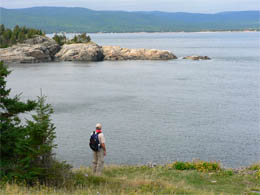
Bill overlooking Middle Head Bay |
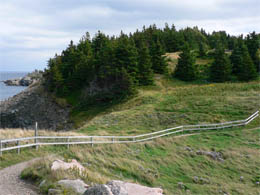
Path through a meadow |

Glorious wildflowers |
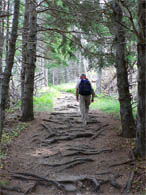
Bill on a trail covered with roots |
The tomato basil I had at lunch was causing me some grief – but I was able to make it out of the woods without incident (if you get my drift – actually I hope nobody got my drift!). We stopped at the Keltic Lodge. By now the sun was losing it’s battle against the rain clouds – so we decided to skip the next hike and drive on to Baddeck, our final destination for the day.
Got in the car and gave “The Bitch” the address to our B&B in Baddeck – and then she, acting extremely passive aggressive, routed us out of the way and through a ferry crossing – costing us another 15 minutes and another 5 bucks. You can’t trust that bitch.
It was about 3 pm or so when we stopped at the Alexander Graham Bell National Historic Site of Canada – wonderful museum. The first hour that we were there, the place was packed with tour buses and tour groups, but they all took off and we had the place to ourselves for a couple of hours.
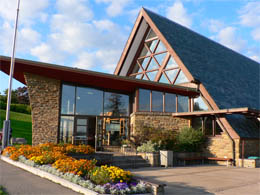
Alexander Graham Bell Museum |
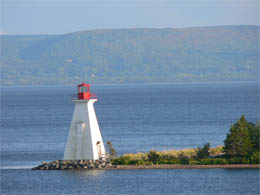
Lighthouse (down the hill from the museum) |
| Alexander Graham Bell – Things we learned from his museum We learned so much about Alexander (and wife Mabel). He was born in Edinburgh, Scotland on March 3, 1847. Alexander’s father and grandfather were pioneers in the science of voice and hearing. In 1862-63, young Alexander spent a year in London with his well-respected grandfather, watching him work. That experience changed Alexander, a lazy, daydreaming teenager, forever. He came home to study and work hard and continue his family’s passion of building a speaking device and developing a visible speech system – Pretty amazing family.
Alexander Graham Bell had three brothers. In 1867, Brother Edward died from tuberculosis and later in 1870, Brother Melville also died from tuberculosis. Alexander almost died from it. Because of the disease, the father decided to move his family to Brantford, Ontario. They sailed to Canada in 1870.
Alexander’s mother was hearing impaired and later became deaf. Because of her (and the family profession), Bell was a teacher for the deaf and a speech therapist at a school for the deaf in Boston.
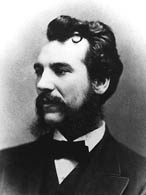
Alexander Graham Bell, 1876, the year the telephone was patented (Photo from Parks Canada) |
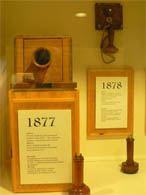
Early model of the phone |
Bell experimented with sound waves, using the inner ear and eardrum from a corpse to reproduce sound waves. From this work, he found a method to transit sound by wire. This breakthrough opened up the world of sound transmission and was the bases for the invention that made him most famous -- the telephone. In the winter of 1874-75, he and Tom Watson worked on the telephone in Boston, and on June 2, 1875, Watson heard Bell’s sound over the device – that was just the beginning!
Bell was passionate about teaching the deaf. In fact, in 1887, Helen Keller’s father brought her to meet Bell. They began a lifelong friendship. Bell helped inspire Helen Keller to greatness.
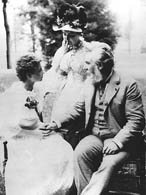
Bell communicates by finger spelling with Helen Keller; Annie Sullivan, Keller’s teacher, stands at center (Photo from Parks Canada)
|
On July 11, 1877, Bell married 18 year-old Mabel, smart and wealthy, and one of his deaf students. He gave her all his stock in Ma Bell. She was the one who ran the business and the home. (She was also very civic minded and established the first public library in Baddeck.) They had two daughters - Elsie May and
Marian.
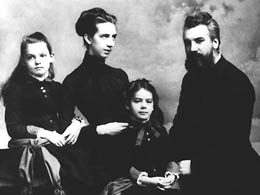
Bell Family Portrait, 1885 – left to right - Elsie May, Mabel (Ma Bell), Marian and Alexander (Photo from Parks Canada) |
Bell loved children and always took time to listen to their ideas. He told his scientist / engineer employees to pay attention to children. He said that children’s ideas are unstructured and fresh – and give you new creative approaches.
The family lived in Washington, D.C. for a time, but they didn’t like D.C.’s heat and humidity or all the attention from their fame and fortune. Mabel wanted a place where the girls could run free in their knickers. In the summer of 1885, Bell visited a friend in Baddeck, Nova Scotia and fell in love with the place tucked away in the highlands. The area reminded him of Scotland. He bought property in Baddeck and then built a 36-room estate, which he called Beinn Breagh (Gaelic for 'beautiful mountain').
"I have traveled the globe. I have seen the Canadian and American Rockies, the Andes and the Alps and the highlands of Scotland, but for simple beauty, Cape Breton outrivals them all." -- Alexander Graham Bell
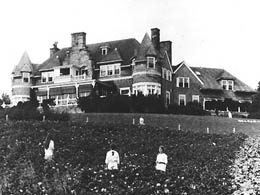
Beinn Bhreagh, built in 1892-1893, Summer home for the Bells
(Photo from Parks Canada)
|
Every Wednesday night, Bell invited a group of guys (from all socio-economic levels) to his place just to talk and discuss issues and ideas – Bell learned from everyone. He was full of life and generous. He even gave an employee a house as a bonus.
Alexander and Mabel were devoted to each other. They were partners in business and in life. They (mostly Mabel) fought lawsuits against his patent on the phone for 18 to 20 years. Together they dreamed and moved mountains. Bell died at Baddeck on August 2, 1922. Mabel died just 5 months later. Their graves are located on the Beinn Bhreagh estate, which is still privately owned by the family. We could only see a part of the house in the distance from the museum.
I was blown away by the diversity of Bells’ inventions in the field of sound, medicine, aeronautics, marine engineering and space-frame construction. The following are just a few of his inventions.
- Wireless phone (which used light to transmit sound)
- Hearing aid
- X-ray machine (used to find the assassin’s bullet in President Garfield’s body)
- Iron lung
- Founder and President of The National Geographic Magazine (and Regent for the Smithsonian)
- Airplane -- The Silver Dart -- With a team of engineers, the plane was designed using massive kite design. The Silver Dart made the first flight ever in Canada in February of 1909. The whole town came out on ice skates on the frozen lake to chase the plane and witness the successful flight. Afterwards, all the townsfolk were invited to the Bell estate for sandwiches.

Flight of the Silver Dart, 1909 (Photo from Parks Canada)
|
- Hydrofoil -- which set a world speed record in 1919. A full-scale model of the HD-4 hydrofoil designed by Bell and his team was on display in the museum. (Casey Baldwin was the lead engineer on the project and was like a son to Bell.)
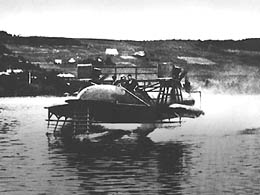
September 9, 1919. World marine speed record set by Bell and Baldwin’s HD-4: 114 kilometers per hour (Photo from Parks Canada) |
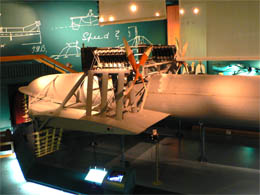
Full-scale model of the HD-4 hydrofoil |
|
We finished all the exhibits about closing time and went into town to find our resting place -- The Telegraph Inn. (Bill booked it earlier that day.) It’s a great old, classy place right in town. Alexander Graham Bell himself once stayed there – probably not in our little room #7. We’re very happy here.
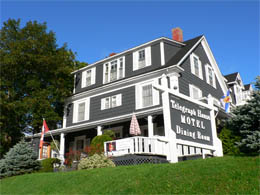 The Telegraph Inn (our home in Baddeck) |
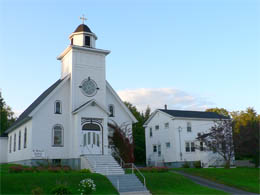
Twilight stroll through Baddeck (Catholic Church) |
We hit the town in search of beer and dinner. First, we walked half a block down to the Yellow Cello (recommended in our guide book). We were disappointed that it was just a pizza place with a once-hip, now aging, guitarist to greet us – “Hey, where are you folks from?” We turned around and went straight back to our little inn for dinner. It has such a cozy, warm dining room – but there was another musician there who ended up entertaining us old gray hairs with elevator tunes like “Mac the Knife”. However, dinner was fabulous -- our stewed chicken redefined “home cooking, comfort food.” After dinner, fat and happy us waddled upstairs to room 7 to watch “60 Minutes” and then figure out the details for the rest of the trip.
9/24 - Monday – Baddeck to Antigonish
I had oatmeal (served with real cream) for breakfast at our cheery little Inn. Bill had pancakes loaded with fresh blueberries – Excellent! We packed up, settled the bill and headed to Louisbourg National Historic Site.
It was another beautiful drive – just how much beauty can one take? There were lots of rivers, pastoral scenes, old wooden houses perched on rolling green hillsides and a couple of restaurants with names that made us chuckle – “McLobster” and “Lick a Chick.”
We got to the town of Louisbourg and stopped at the Visitor’s Center to get the lay of the land. The guy gave us directions to Fort Louisbourg, the premiere Canadian National Historic Sight. It was only a couple of miles down the road. We got our tickets (love those Canadian Park Passes), looked around the museum (located on the edge of the fort’s property) and then took a tour bus to the settlement. (A friendly couple from Pittsburgh and their friend and local guide were on the bus.)
We couldn’t believe our eyes – this place was bigger than Disneyland. Louisbourg, named after King Louis the 14th, was founded by the French in 1713, who were relocating from Newfoundland. The French government’s intent was to create another Paris on this spot for the New World. They spared no expense. The town (and fortress) became a thriving seaport and capital of Cape Breton Island with one of the busiest harbors in North America (right up there with New York and Boston). In the early 1740’s, the town population was around 2,500 and another 700 soldiers.
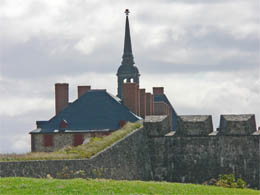
Louisbourg – The Town and The Fortress |
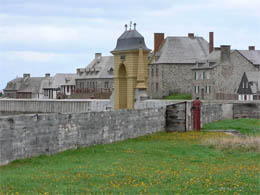
Town facing the harbor |
The French chose the location for Louisbourg (Paris of the New World) because it was in the same latitude as France and they figured the weather wouldn’t be a problem. They didn’t know about the cold, artic winds. They also didn’t know about the warrior-like, slash and burn Brits, supported by the New Englanders, who easily defeated the French army in a couple of battles.
In 1745, 4,000 New Englander troops plus the British Royal Navy captured the fort and town from the back. The French military was prepared to protect the harbor, but did not expect an attack from the marshlands behind the town. The British Royal Navy then cut off the harbor in the front. Controlling the back and front, the troops starved the French out. After 6 weeks with no food or supplies, the French surrendered. Those who were not killed or on the verge of hunger, were deported back to France. The British and New Englanders occupied the fort for the next five years until a treaty gave the place back to the French.
About ten years later (in 1758), 30,000 British forces recaptured the place and then deported the French citizens once again back to France. It only took a couple of years for the British to decide to pack up and abandoned the place. Instead of just leaving, the British hired miners to demolish the buildings and walls. It took them 8 years to completely destroy the town and fortress. Louisbourg was never re-occupied. No one ever built another city over the ruins, leaving behind a rich time capsule.
In 1928, Louisbourg was declared a National Historic Sight, but remained desolate. In 1961, the Canadian Government began a $25 million dollar project to unearth the time capsule. They hired out of work coal miners and artisans to recreate the town buildings, yards, gardens and streets as they were during the early 1740’s, when Louisbourg was France's key trade and military center in the New World. They reconstructed about one-quarter of the original town. Every detail was perfect – they used the original records (750,000 pages of documents and 500 maps and plans) copied from archives in France and Quebec. The town is authentic and the National Park employs people to act as town folks from the 1740’s. They entertained us with their stories and their antics.
The bus from the museum let us off at the fish merchant’s house. His wife kept a fire going. The fish merchant told us about the lucrative cod fish business – which provided great wealth for France. France desperately needed cod (or a cheap fish) for the 144 days Catholics could only eat fish. The waters in Canada were filled with cod. Fishing with only hooks and weights, a couple of fishermen in a single little boat could bring in one ton of cod a day.
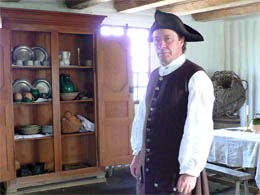
The Fish Merchant |
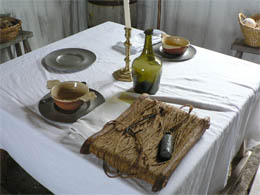
Hook and line to catch cod (on Fish Merchant’s table) |
The cod they didn’t eat (wet cod), they dried. For the drying process, they split the cod, removed the backbone and head, salted it and laid it on racks to dry. The dry cod would last for up to a year. They saved the livers and then squeezed out the cod liver oil for lamps.

Racks for drying cod |
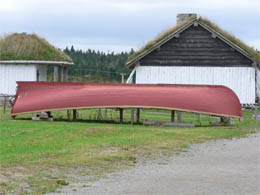
Boat outside the Fish Merchant’s house |
Only the merchants (like the little fish merchant we met) and others close to the king were given the right to make a profit. There was a strong caste system in place and no one in the lower echelons could get ahead. Records showed that a seamstress in the town made three candles to sell for a profit and was punished for her attempted capitalism. Only one guy seemed to break the caste system barrier. He became a respected judge in the colony. However, when he returned to France, he had to return to his former lowlife status.
From the fish merchant’s house, we walked to the main gate –the Dauphin Gate. We were scrutinized by the guard and suspected of being British spies, but, after a few jokes, we were allowed to pass.
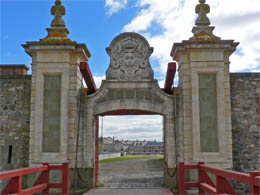
Main gate –the Dauphin Gate |
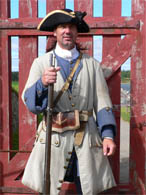
Guard at gate |
We walked into the town, amazed by the authenticity and town characters going about their daily lives.
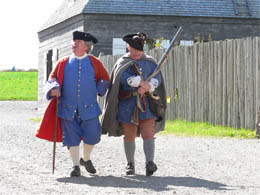
Soldiers scroll through town |
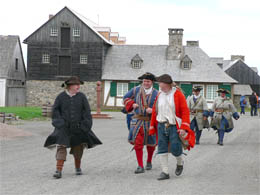
Street scene |
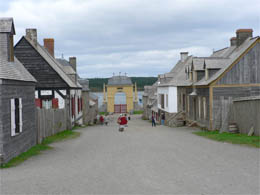
Main Street leading to the harbor |
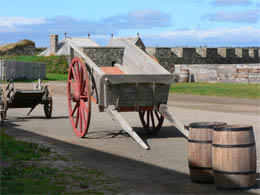
Wagon in the street |
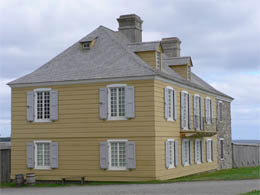
Estate (owned by the upper class) |
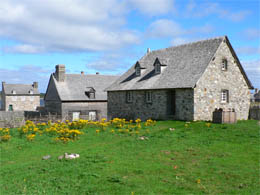
Farmhouses on the outskirts of town |
Some of the town residents we encountered were the inn keeper, restaurant owner, blacksmith, soldiers (who had the toughest life), a milkmaid feeding a strange looking goat typical of that time (Lebanese origin), high ranking officer’s wife knitting silk stockings, town drunk (chained to a pole in the town square as punishment) – the list goes on.
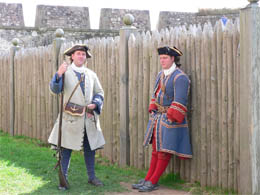
Soldiers |
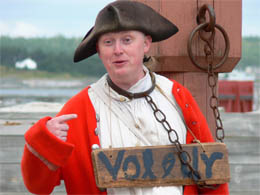
Town Drunk |
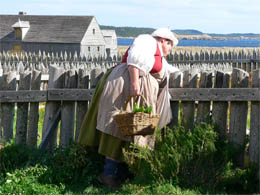
Milkmaid feeding a goat |
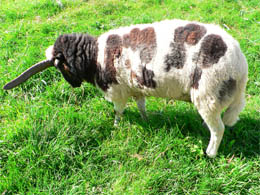
Strange looking goat |
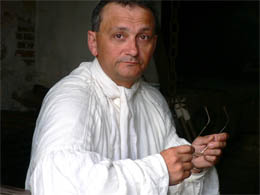
Blacksmith |
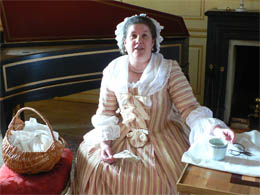
Officer’s wife |
The day was a cold and blustery with huge gusts of 50 mph wind – enough to knock you over, but the sun was shining brightly. We gathered for the 11:30 walking tour lead by Meagan, our guide. She was a Francis McDerment (of “Fargo” fame) look-a-like and was filled with information, humor and lots of spunk. (She did have a stud in her tongue – but still could clearly enunciate all the words.) She described the place as Disneyland built over a graveyard because many people died (due to war, famine or disease) and were buried here under our feet. Archeologists keep discovering more and more bones.
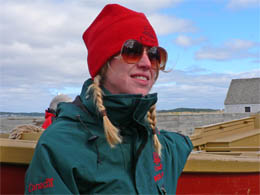
Meagan, our guide |
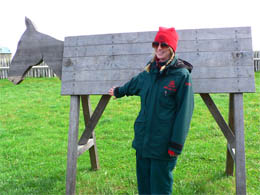
Meagan and the wooden horse used to punish soldiers |
| Notes from Meagan, our guide Fort Louisbourg was founded by the French in 1713. They built a “Paris” in the New World and it became the capital of French holdings the Atlantic Canada.
Everything was imported. Meticulous records were kept – everything had 3 copies – one set sent to France, one to Quebec and other governmental agencies. From these records, historians learned many details about the place. A couple of examples -- The King’s Representative had a good life – His household inventory showed over 6,000 wine corks. The city accountant, a bachelor, was corrupt and ended up in prison in Austria.
In its heyday, Louisbourg was a center for trade with France, French West Indies, Quebec, Acadia and New England. Over a hundred sailing vessels a year came to its harbor.
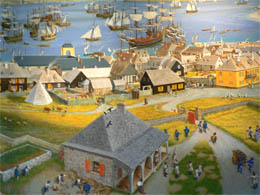
Mural of Louisbourg, 1740’s |
Fort Louisbourg was a military stronghold to protect France’s interests in the new world. (The French once captured British Colonel Bradford and held him prisoner in Fort Louisbourg. At that time, war was a gentlemanly game. Bradford was allowed to go to parties and teas with the locals. Here he learned the secrets and military weaknesses. He was released and then returned with soldiers to attack again.)
There weren’t many Aborigines in the area. French always got along great with the Aborigines. Fur trapping for beaver pelts was a fairly big business until the men’s hats went out of style.
Property was set aside to build a church. A cross was installed, but the church was never funded. The cross was taken by New Englanders in a siege of 1745. Harvard University in Cambridge, Mass. held it for years and finally returned it in 1995.
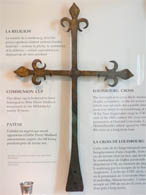
Louisbourgh Cross
|
Soldiers had the toughest life. Most of them were from France and were either street kids or prisoners. They were promised good weather and beautiful women They were also promised 9 leaf (form of money) per month, but weren’t told that 7 of that would be charged for room and board. They were on duty 24 hours, then off for 48 hours. Three were assigned to one bed – but only a couple shared the bed because one of the bed partners was on duty. Soldiers were expected to get another job. Most women would not marry soldiers. Soldiers due to be released stayed in protected quarters so they wouldn’t be murdered by other soldiers who wanted to take their place and be returned to France. We’re talking a really tough life.
The people were filthy and covered in lice – even the wealthy. It was well known that the French were dirtier than the British. Some speculate that the dirty French survived longer than the British because their clogged up pores kept out the germs. Everyone, both men and women, wore camisole tops. Everyone had a minimum of five camisoles each. Each morning, they threw their bedpan waste out on the street, then used their camisoles to wipe their private parts.
Since most of the people couldn’t read, the stores had to be creative with their signs. The hotel hung spruce branches on their sign, so people coming into town would know where to go to find a hotel.
Catholic sisters came and set up a school. However, the boys went to work at age ten while the girls stayed in school. The parents wanted to educate their daughters so they could “marry up.” Documents from the 1700’s show that the women signed their names while the men only used an “X.”
Only one café in town was suitable for proper people. People who frequented these places did not have to bring their own cutlery. The other cafes didn’t provide cutlery mainly because the customers would steal it. |
I was fascinated by all the stories Meagan told us. After a couple of hours, the tour was over and we were free to roam the windy, cold streets on our own. It was great tucking into a little place with a blazing warm fire.
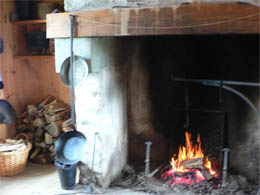
Cozy inn |
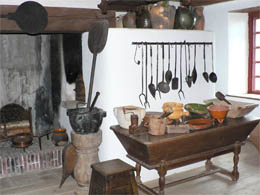
Another inviting place |
We bought a loaf of soldier’s bread (from an original 1740's recipe) for $3. It’s was very hearty -- 80% wheat and 20% rye. We nibbled on it for lunch. It kept many souls alive.
We stopped at the King’s
Bastille– a castle-like building and open courts fortified by surrounding walls. In 1752, France built the first astronomical observatory in Canada right here in the
Bastille
. The
Bastille
housed a chapel, soldiers' quarters, the governor’s quarters and other rooms. One important citizen, the King’s Representative, lived royally in the King’s Bastille. However this guy lost a leg in a naval battle and was plagued with arthritis, gout and all sorts of other ailments.
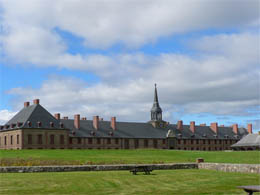
King’s
Bastille
|
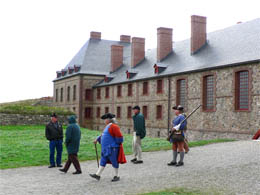
Outside the King’s
Bastille
|
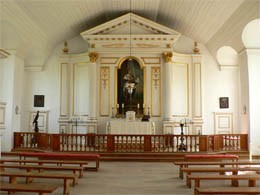
Chapel |
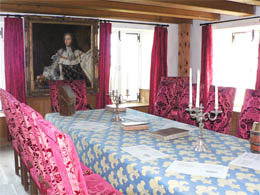
Governor’s dining room |
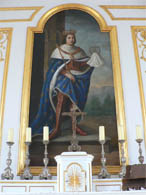
Chapel |
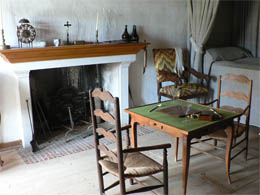
Officer’s quarters |
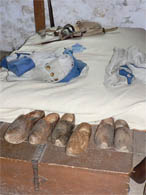
Soldier’s bed (3 to a bed) |
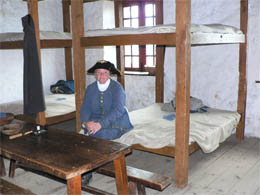
Soldiers' quarters |
We watched some soldiers march inside the walls of the King’s
Bastille
and then fired a canon.
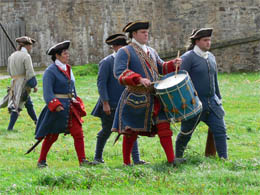
Soldiers marching |
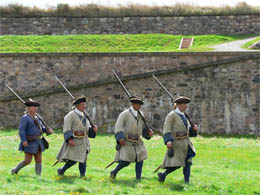
More soldiers marching |
Also in the
Bastille
was a fascinating museums displaying unearthed treasures.
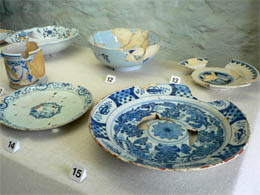
Somebody’s China |
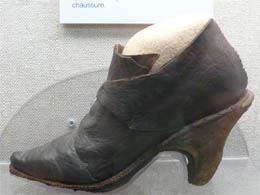
Woman’s shoe |
At about 3:00, we returned to our car. We made one stop to see the Louisbourg lighthouse. It was Canada’s first lighthouse, built in 1734 – but of course, the original lighthouse has been replaced several times.
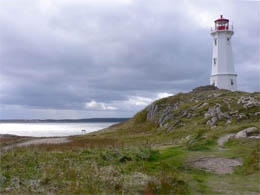
Louisbourg Lighthouse |
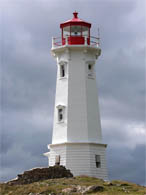
Louisbourg Lighthouse |
After our full day at Louisbourg, it was too late and the weather too blustery to tour the coast (around Chedabutcto Bay). We decided to call it a day and drive to Antigonish to spend the night.
At first, we got some sprinkles, then came the rain and powerful winds. We stopped at the Visitor’s Center in St. Peter’s to book a room for Antigonish and checked our emails. Friendly Ann Marie at the Visitor’s Center had to make several calls to find a place (Chateau Motel). Just our luck – Antigonish is hosting a homecoming celebration.
We drove another one and half hours. The rain stopped, but the winds were fierce and the ocean angry. As we drove along the ocean and over the causeway, the huge waves were splashing over the roads, slamming a few birds to their deaths.
We finally got to Antigonish, a junky town. Our sad sack motel was right by a noisy road. Sometimes you win, sometimes you don’t. However, we did O.K. with our dinner -- The great little restaurant Bill picked out – Sunshine on Main (332 Main Street) was delightful. I had the western pizza and Bill, the seafood chowder. Feeling better, we went back to our room to figure out what to do in Halifax.
|











